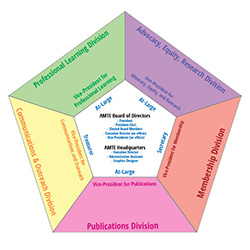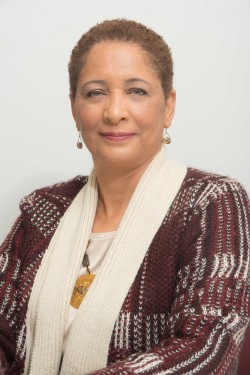AMTE of the Future:
Restructuring AMTE’s Governance to Support Our Growing Influence
In the April 2015 meeting of the AMTE Board of Directors, a subcommittee was established and commissioned to reexamine the organizational structure of AMTE with the aim of ensuring the organization is well-positioned to address its stated mission and goals. This call for an analysis was prompted by the Board’s commitment to sustaining and advancing AMTE’s position as the lead organization in mathematics teacher education. After several months of analysis, the subcommittee presented a recommendation for the restructure of AMTE, a recommendation accepted by the AMTE Board. Subsequently, in the 2016 Annual Business Meeting held at the AMTE Conference, I informed members of the ongoing work of the Board to restructure the organization and provided the rationale for the restructure. Information about the restructure was also published in the Spring 2016 issue of Connections in my President’s Column. The Board has remained immersed in this development and in the June 2016 board meeting the plan for the restructure was completed and approved. In this column, I revisit the rationale and provide detailed information about the restructure.
Rationale for Restructuring
The rationale for the restructure is centered in two core outcomes of the analysis. First, there are gaps in how the mission and goals of AMTE are addressed. Second, the current structure of the governance does not adequately situate the organization to respond to the plethora of issues and challenges in mathematics teacher education.
As a reminder, AMTE’s Constitution states the following goals:
- Promote effective mathematics teacher education programs and practices;
- Promote communication and collaboration among those involved in mathematics teacher education;
- Promote research and other scholarly endeavors related to mathematics teacher education;
- Promote ongoing professional growth of mathematics teacher educators;
- Advocate for effective policies and practices related to mathematics teacher education at all levels; and
- Advocate for equitable practices in mathematics teacher education, including increasing the diversity.
The Board sought a governance structure that would more effectively support the capacity to scale up efforts with respect to these goals, with particular attention paid to initiatives for equitable practices, effective policies, and professional growth of mathematics teacher educators.
While there was a time when many AMTE members viewed the Annual Conference as the main focus of the organization, our organization is now much more! Below is a partial list of spaces in which AMTE resides:
- AMTE publishes
- the Mathematics Teacher Educator journal in collaboration with NCTM,
- Contemporary Issues in Technology and Teacher Education - Mathematics online journal in collaboration with SITE,
- the Connections newsletter, and
- books and monographs.
- AMTE engages regularly with other organizations related to mathematics teacher education such as the Conference Board of Mathematical Sciences, the Mathematics College and Career-Readiness Coalition, and the National Technology Leadership Initiative.
- AMTE engages in meetings of other organizations to react to documents and collaborate in ongoing initiative in the community of the mathematical sciences (e.g., MET, CAEP, Common Vision, TPSE, ESSA, and so on).
- AMTE engages in advocacy about issues related to MTE (e.g., taking a position, interacting with partner organizations, and being at the table for called meetings such as the National Academy of Sciences meeting for the discussion of a mathematics education board and NCTM’s called meeting for collaboration on equity and access in mathematics education).
- AMTE creates and disseminates policy documents (e.g., the developing Standards for Mathematics Teacher Preparation , Standards for Elementary Mathematics Specialists , AMTE Review of CAEP Draft Standards).
- AMTE engages in member professional development, including webinars and mentoring.
- AMTE gives numerous awards honoring MTEs for their significant contributions to the field.
- AMTE administers the STaR program for early career faculty in MTE.
Current and New Structure for AMTE Governance
Before describing the new structure, we will revisit the current organizational structure. The current structure for the Board includes seven elected members and seven appointed members. The elected members are President, President-elect/immediate past, Secretary, Treasurer, and three Members-at-large. The appointed members are the Executive Director and the six directors: Affiliates, Conference, Newsletter Editor, Publications, Sponsorship, and Website. Additionally, AMTE has 16 standing committees. The current structure was put into place to support the work of a growing organization, recognizing that unlike some organizations of similar size that have many full-time headquarter employees, AMTE is instead a volunteer-driven organization and the board members, directors, and standing committee members must carve out time from their busy working lives to carry out their AMTE responsibilities.
In the development of the new structure ( see the organizational chart below ), categories of AMTE work were mapped to the AMTE mission and goals. Five categories of work were identified. These categories are now our divisions: (a) membership, (b) professional learning, (c) publications, (d) advocacy, equity and research, and (e) communications and outreach. Each division will be led by a vice president, appointed by the President with the approval of the Board. Although each vice president will be responsible for overseeing the work carried out within his or her respective division, the work of AMTE often crosses divisions, thereby requiring vice presidents to work closely together with each other and with the presidents and executive director. For example, work of the Annual Conference intersects all divisions.
Committees within the Restructure
The Board examined all committees for alignment to the ongoing work, and each committee was either placed within a particular division or the work of the committee was subsumed into a different committee. In some cases, the Board determined that the work of a committee would best be carried out by individuals. As a result, each division contains associate vice-presidents and, in most cases, the associate vice-president will oversee a committee comprised to carry out the work.
Elected Board within the Restructure
Within the new structure, the current composition of the elected Board will be maintained; this is shown in the organizational chart. However, the restructure changes the way in which the elected Board will operate. The restructure is designed so that the major work of AMTE takes place within divisions, and in addition to the vice president, associate vice-presidents, and committee members, each division will have one assigned Board liaison. Regular division meetings will be held. Also, the division vice presidents will meet periodically with the presidents and Executive Director. The full Board of elected and appointed members will continue to meet to review, provide feedback and approve the ongoing work within and across divisions, but the current practice of monthly meetings of the full Board of Directors will no longer be necessary.
Next Steps
The next steps for the Board are to: (a) work with existing committees for the transition of eliminating committees, (b) appoint vice-presidents and associate vice-presidents, (c) work with the Constitution Committee to update the bylaws to reflect the restructure, and (d) complete the process of incorporation (see Executive Director’s report in this issue). Updates to the by-laws and approval of the revised by-laws of the newly incorporated AMTE will need to occur in the Annual Business Meeting at the 2017 Annual Conference. Given that some committees will be eliminated or folded into other committees under the restructure, it was not necessary for AMTE to request members to volunteer for committee appointments for 2017. As the transition moves forward, members will be updated on procedures for committee appointments.
Your comments and questions about the restructuring of the governance of AMTE are welcome. Please upload your feedback using the URL below.
https://amte.net/form/2016/feedback-on-restructuring
Christine D. Thomas, President
 |
 |

